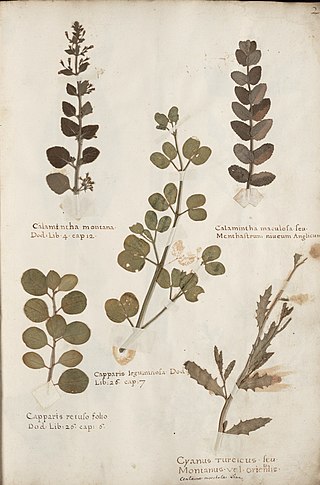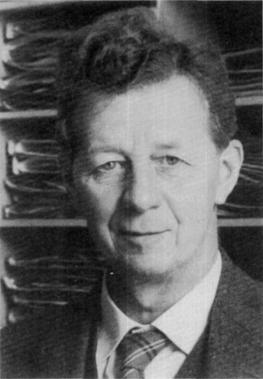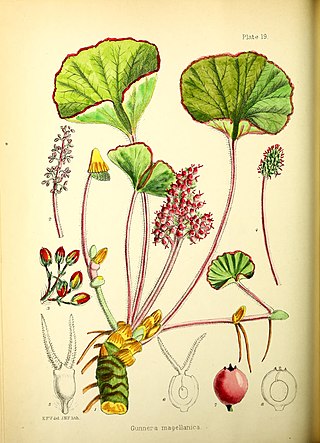Related Research Articles

A herbarium is a collection of preserved plant specimens and associated data used for scientific study.

Katherine Esau was a pioneering German-American botanist who studied plant anatomy and the effects of viruses. Her books Plant Anatomy and Anatomy of Seed Plants are key texts. In 1989, Esau received the National Medal of Science "In recognition of her distinguished service to the American community of plant biologists, and for the excellence of her pioneering research, both basic and applied, on plant structure and development, which has spanned more than six decades; for her superlative performance as an educator, in the classroom and through her books; for the encouragement and inspiration she has given to a legion of young, aspiring plant biologists; and for providing a special role model for women in science." When Katherine Esau died in year 1997. Peter Raven 'Director of Anatomy and Morphology' of 'Missouri Botanical Garden' remembered that she absolutely dominated the field of plant Biology even at the age of 99.
John Patrick Micklethwait Brenan (1917–1985) was a British botanist who became director of the Royal Botanic Gardens, Kew.

Sir David Prain was a Scottish botanist who worked in India at the Calcutta Botanical Garden and went on to become Director of the Royal Botanic Gardens, Kew.
Francis Wall Oliver FRS was an English botanist whose interests evolved from plant anatomy to palaeobotany to ecology.

Ronald Melville was an English botanist, based at the Royal Botanic Gardens Kew. He is chiefly remembered for his wartime research into rosehips as a source of vitamin C, prompted by the epidemic of scurvy amongst children owing to the reduced importation of fresh fruit. His research concluded that hips from the common Dog Rose, Rosa canina, held the highest concentration of the vitamin. In later years, he challenged the two-species taxonomy of the British elms proposed by Richens, identifying five distinct species, several varieties and numerous complex hybrids. Melville assembled a large collection of elm species, varieties and hybrids which are still growing at Royal Botanic Gardens Kew's Wakehurst site.
The Linnean Gold Medal is a medal awarded by the Linnean Society of London in "special circumstances" for "services to the Society". As the society's highest honour it has, to date, only been awarded three times.

Lilioid monocots is an informal name used for a grade of five monocot orders in which the majority of species have flowers with relatively large, coloured tepals. This characteristic is similar to that found in lilies ("lily-like"). Petaloid monocots refers to the flowers having tepals which all resemble petals (petaloid). The taxonomic terms Lilianae or Liliiflorae have also been applied to this assemblage at various times. From the early nineteenth century many of the species in this group of plants were put into a very broadly defined family, Liliaceae sensu lato or s.l.. These classification systems are still found in many books and other sources. Within the monocots the Liliaceae s.l. were distinguished from the Glumaceae.
Alan W. Meerow is an American botanist, born in New York City in 1952. He specializes in the taxonomy of the family Amaryllidaceae and the horticulture of palms and tropical ornamental plants. He also works on the population genetics and molecular systematics of cycads and palms.
John Dransfield is former head of palm research at the Royal Botanic Gardens, Kew, United Kingdom.
Paula J Rudall (born 1954) is a British botanist, who was Head of the Micromorphology Section (1999–2014) and Head of the Department of Comparative Plant and Fungal Biology at the Royal Botanic Gardens, Kew.

Elinor Frances Vallentin (formerly Nichol; was a British botanist and botanical illustrator who made scientifically significant collections of botany specimens in the Falkland Islands. She co-authored the book Illustrations of the flowering plants and ferns of the Falkland Islands in 1921 with Enid Mary Cotton, a fellow botanist. This work was regarded as being particularly valuable because of Vallentin's botanical illustrations. The standard author abbreviation Vallentin is used to indicate this person as the author when citing a botanical name.

Pieter Baas was a Dutch botanist and an emeritus professor of plant systematics at the Leiden University, who served as director of the Rijksherbarium of Leiden University between 1991 and 1999. When the institute was faced with budget cuts in 1993 he managed to preserve the collection by joining it with the university collections of Wageningen and Utrecht. This led to the founding of the National Herbarium of the Netherlands in 1999. Baas subsequently became director of the institute and served until 2005. As a botanist, Baas specialised in wood anatomy, and was an elected fellow of the International Academy of Wood Science.
Peter Goldblatt is a South African botanist, working principally in the United States.
Herbert Fuller Wernham was a British botanist, who from 1909 to 1929 worked at the British Museum, as an assistant in the botany department. From 1911 to 1921 he published extensively on tropical plants and many genera, retiring in 1921 due to ill health (alcoholism).

Etelka Anne Leadlay is a British botanist.
Gerald Ernest Wickens B.Sc., M.Sc., Ph.D., F.L.S. was a British botanist.
Grenville 'Gren' Llewellyn Lucas was a British botanist, conservationist, and Keeper of the Herbarium and Library at Kew Gardens.
Susyn M. Andrews is a British taxonomic horticulturist. Her research has focussed on temperate and subtropical woody plants, especially Holly and Lavender.
Charles Russell Metcalfe (1904–1991) was an English botanist and explorer, who undertook botanical collecting expeditions in west Cameroon.
References
- ↑ "HUH – Databases – Botanist Search". kiki.huh.harvard.edu. Retrieved 3 November 2016.
- ↑ The Linnean, Vol 21(2) (2005), p. 2
- ↑ "Wiley: Plant Anatomy: An Applied Approach – David F. Cutler, Ted Botha, Dennis Wm. Stevenson". wiley.com. Retrieved 3 November 2016.
- ↑ "V14s108p184 all by Kew Guild Journal – issuu". issuu.com. Retrieved 3 November 2016.
- ↑ "Cutler, David – Kew: Science Directory". kew.org. Archived from the original on 12 March 2016. Retrieved 3 November 2016.
- ↑ Annual Review 2017, Linnean Society, pp. 32, 34
- ↑ International Plant Names Index. D.F.Cutler.